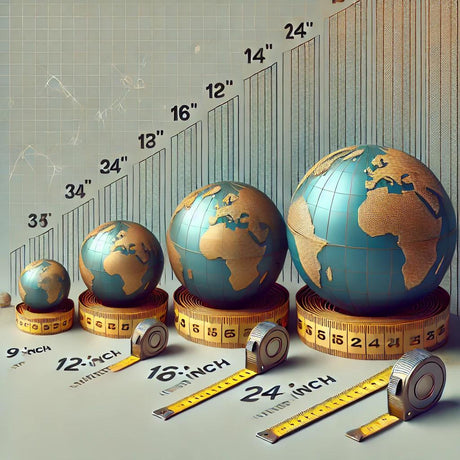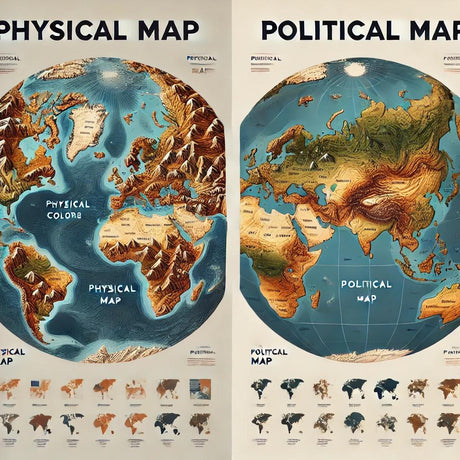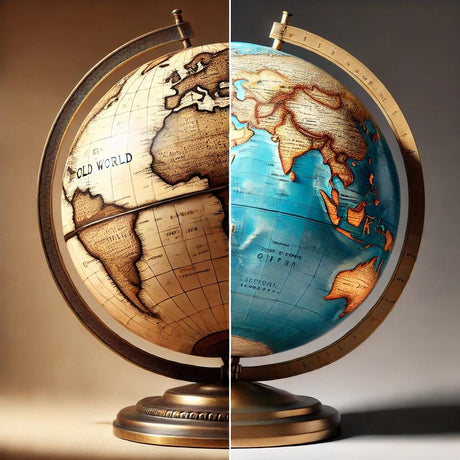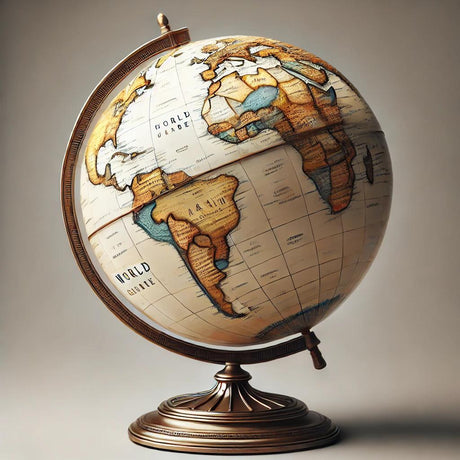A History of Changes
Just how old is your globe? Does it still show the U.S.S.R.? How about East & West Germany, Yugoslavia, the Federation of Rhodesia, Burma, Ceylon, and the Trucial States? Does it list the cities of Bombay, Peking, and Saigon? If you can find any of these place names on your current globe, it might be time for a new one. The world has changed tremendously in the last fifty or so years, and that fact can be seen in the more modern globes available today.
Entire countries have disappeared while others have sprouted like mushrooms after a good rain. The U.S.S.R. was once the largest country in the world; it spanned eleven of the world's twenty-four time zones! There are now fifteen new nations where it once stood; does your current globe show these countries: Armenia, Azerbaijan, Belarus, Estonia, Georgia, Kazakhstan, Kyrgyzstan, Latvia, Lithuania, Moldova, Russia, Tajikistan, Turkmenistan, Ukraine, or Uzbekistan? Unless you're a dedicated fan of the Olympics, you may never have heard of more than a handful of these countries.

The former Yugoslavia practically turned itself inside out to produce seven new nations. After the bitter conflict in the 1990s, these countries emerged onto the world stage: Bosnia and Herzegovina, Croatia, Kosovo, Macedonia, Montenegro, Serbia, and Slovenia. They are just a few of the many new countries to have premiered in the last fifty years. According to National Geographic, they currently list 195 independent countries of the world, roughly three-quarters more than we recognized in 1963. That's a lot of change over a relatively short period!
Countries that disappear and reappear, switch identities, or rearrange themselves aren't the only reason for the vast increase in the number of countries in the world. Many former colonies are now independent countries in their own right and have joined the other players on the world stage. The end of the colonial era is the primary reason for the enormous growth in the number of nations in the last half of the 20th century.
Sixteen new countries have emerged in Africa alone, along with dozens of other newly independent former colonies in Oceania and the Caribbean. Some of these former colonies seem to have had identity crises: The Federation of Rhodesia and Nyasaland became Zambia and Malawi in 1964 and then became the single nation of Zimbabwe in 1980! There are other countries which have also merged into one; besides the well-known examples of East and West Germany along with North and South Vietnam, did you know there was once a North and South Yemen? How about Tanganyika and Zanzibar? They morphed into Tanzania in 1964—maybe the best example of how to merge two names into one that represents both nations.
So we know there have been a myriad of changes, but how does a person date their globe? There are a few items to understand before digging in.
Why should I date my globe?
People date globes for one of two reasons. They either want to determine if they should go out and purchase a new world globe or they want to assess the value of their world globe for resale. It can also be a fun and educational experience identifying the geopolitical makeup of the world.
How are changes determined?
Each globe manufacturer sets its process for determining eligibility and implementing a change. For example, Waypoint Geographic and Replogle Globes both state that they make changes based on the US State Departments' list of recognized states. What does that mean? For example,
Palestine is not recognized as a state by the US State Department, so it will not typically be recognized on a globe made for the US market.
Taiwan is both an independently declared state as well as claimed by the People's Republic of China. Globe companies may choose to show this country as a part of China or independent as the State Department diplomatically recognizes both the country's claim.
How often are changes made?
Manufacturers are typically shy about indicating whether a change has been made on a particular map until they have exhausted their inventory and production calls for the updated map.
It is safe to assume within a year of change, the larger manufacturers have updated their maps, and the current version of their products includes the change. Keep in mind that most manufacturers use several styles of maps for different products they offer, so cartographic updates may come at different times.
Most importantly, we should keep in mind that most changes are insignificant, such as small city name changes, etc. These changes should occur during regular updates; however, very few people will be aware of such modifications, and most of the time, this has no specific impact on the product's use.
What is the best method of determining a globe's age?
Since there is no published list of when a globe manufacturer has made changes to its product, the best way to get a general idea of how old your globe is would be to find a reliable source of name change information. In general, there will not be a recognizable date printed on your world globe.
We favor starting with the list found on Wikipedia called Timeline of Historical Geopolitical Name Changes. You will find a comprehensive list and potentially a bit overwhelming at first. Not knowing the date the globe was published, we suggest starting about ten years earlier than when you acquired the world globe.
Find a name change on the list and see if you can find it on the globe. If you can, then start working your way up the list to the most current changes. If you can't find it, work your way down the list until you can identify an old name.
As noted above, you should keep in mind that if your globe is for the US market, some names may not appear at all. For a list of countries recognized by the US State Department, visit their page of the Independent States in the World.
How much is my old globe worth?
Great question! But not an easy answer. For more information on this subject, we suggest reading our article on How Much is my Old Globe Worth?
Can I get an updated globe only?
Updated globe programs are available from Waypoint Geographic and Replogle Globes on specific models at a discounted price, which is typically 50% off the cost of a new fully assembled globe plus shipping. Some of the requirements you should be aware of:
The globe ball and map must still be in production and of the same brand. The diameter of the globe must fit the meridian of the old globe, as manufacturing changes over time, and the hardware used to mount the globe changes. Therefore, globes more than 15 years old may not have a suitable replacement. If the meridian also requires replacement and the globe stand is not a current model, it is unlikely a replacement can be made available.
As a rule of thumb, a globe company will not dispatch a replacement globe ball without having images of the stand and meridian as well. This is to ensure you do not receive the wrong replacement.
Now that you know how to date a globe and you have determined it is an excellent time to replace it, shop our store to view our large selection of available world globe styles and sizes.




